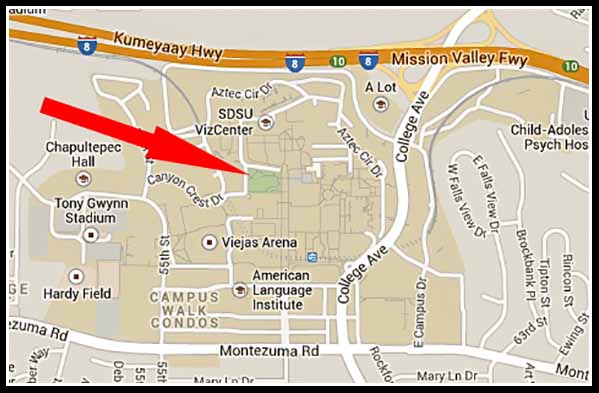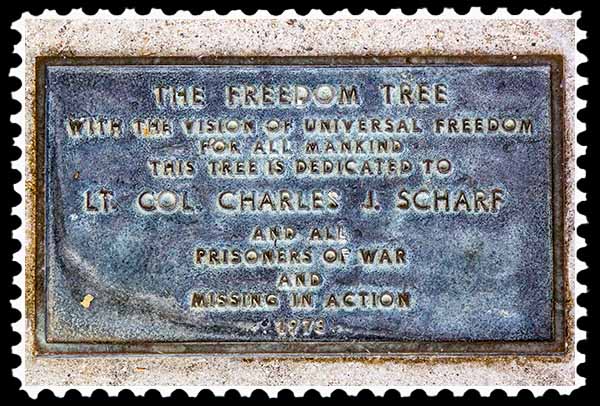I have a Bachelor of Science in Forest Management from Texas A&M University, and although I’ve never used the degree other than to proudly occupy a space on a wall, I still have this abiding love for trees. Thus, when I’m out and about, I tend to notice trees. Tall ones, short ones, bushy ones, skinny ones, flowering ones, dying ones….
One of the places that I go walking quite often is the campus of San Diego State University. The walk to the campus is 1.7 miles, which takes me about 30 minutes. An exploratory walk around the campus takes however long I want it to take, depending on opportunities for photography.
Recently I was at the Turtle Pond in Scripps Park, smack dab in the middle of campus:
I usually don’t walk on the grass (my wise old grandmother taught me to walk on sidewalks), but I saw what looked like a plaque or memorial of some sort under this very tall tree. Tall trees in San Diego usually are eucalyptus trees, but this tall tree was a Western Sycamore (Platanus racemosa; also known as a California Sycamore, California plane tree, and, in Spanish, Aliso).
Western Sycamores get to be about 35 feet tall (this one is right there, if not a little taller!), but one of this height in an urban landscape is quite rare since they like a goodly amount of water. However, this one is planted at the bottom of a grassy slope, and to get grass to look nice in a desert environment like San Diego’s, well, you have to water it. Ergo, this tree probably gets more than its share of water.
If you look in the shade on the ground, just to the left of the trunk, you can see a round, dark spot, which is the plaque that caught my attention:
THE FREEDOM TREE
WITH THE VISION OF UNIVERSAL FREEDOM
FOR ALL MANKIND
THIS TREE IS DEDICATED TO
LT. COL. CHARLES J. SCHARF
AND ALL
PRISONERS OF WAR
AND
MISSING IN ACTION
1979
This tree probably was about a year old, with a balled root, when it was planted in 1979. Thus, it has grown to its maximum height in just 35 years, one foot for each year. That’s quite a growth rate for a sycamore! Again suggesting that it gets all the water it needs.
Of course, being the history buff that I am, I had to see if I could find out any information about Lt. Col. Charles J. Scharf. A quick Google search took me to Charles Scharf’s entry at the POW Network.
Charles Scharf was born in San Diego on March 20, 1933 (Hey, I’m also a March baby!). According to the entry:
Col Scharf and a fellow crew member took off in their F-4C Phantom IIs from Ubon Royal Thai Air Force Base in Thailand on October 1, 1965. Their mission was to attack an enemy concentration and a major highway in North Vietnam. After the lead aircraft developed problems en route, Scharf assumed the lead of the two other F-4s in the flight. After he completed two bombing runs, Scharf’s aircraft was hit by enemy fire. His radio transmission of “Mayday, Mayday, Mayday” was heard by the other two aircraft. One radioed “Gator 3 (Scharf’s call sign), you’re on fire, you’d better get out! Bail out, Gator 3!” Scharf’s plane began to disintegrate and a parachute was seen leaving the aircraft.
The other two aircraft lost sight of the parachute, and circled the area for about 10 minutes where Scharf’s aircraft had crashed and burned but no radio or visual contact was made then nor in subsequent aerial search and rescue operations.
….
Charles J. Scharf was promoted to the rank of Colonel and Martin J. Massucci to the rank of Major during the period they were maintained missing in action.
A news release from the United States Department of Defense on November 9, 2006:
The Department of Defense POW/Missing Personnel Office (DPMO) announced today that the remains of a U.S. Air Force officer missing in action from the Vietnam War have been identified and are being returned to his family for burial with full military honors.
He is Col. Charles J. Scharf of San Diego. His funeral is scheduled for Nov. 30 at Arlington National Cemetery near Washington D.C.
Interestingly, though, there was a later entry for Charles Scharf in the POW Network, dated April 9, 2013, from Steve L:
Col. Charles Scharf has been a prisoner since 1 Oct 1965. My mother, Barbara Lowerison has fought very hard for 40 yrs to bring him home. She passed away 8 Jan 2012. In Oct 2011 a Vietnamese male arrived at her home. He said he had been in prison with Charles Scharf in Hanoi 2 levels below ground. We know this is true because he relayed information only my mother and myself know. He had to see Uncle Chuck in order to say what he said. He also said Col. Scharf has one arm missing which accounts for the bone fragment sent back. Our government has always known where our prisoners are, a fact made clear when they sent someone to kill several prisoners saying they were collaborators. The operative could clearly see they were prisoners and did not take the shot. Col. Scharf was on that list with 4 others. Why are these national heroes still there?
So….
Is Lt. Col. Charles J. Scharf a POW, still MIA, or buried with full military honors in Arlington National Cemetery?
Looking for real estate services in San Diego County?
I can highly recommend James Frimmer, Realtor, CDPE
CA BRE #01458572
If you’re looking for a home inspector,
I recommend Russel Ray — that’s me!








Hi, in 1979 year born my son number 1, Mathias, see you later
LikeLike
You bring to the surface many, many unanswerable questions about war. But indeed… Which is better? To have perished or have become a prisoner for the rest of your life. Nevertheless, the evidence suggests his death and Arlington is a most serene place for a soul lost at war.
LikeLike
Pingback: Google loves me (and how to get Google to love you!) | Russel Ray Photos
Curious.
LikeLike